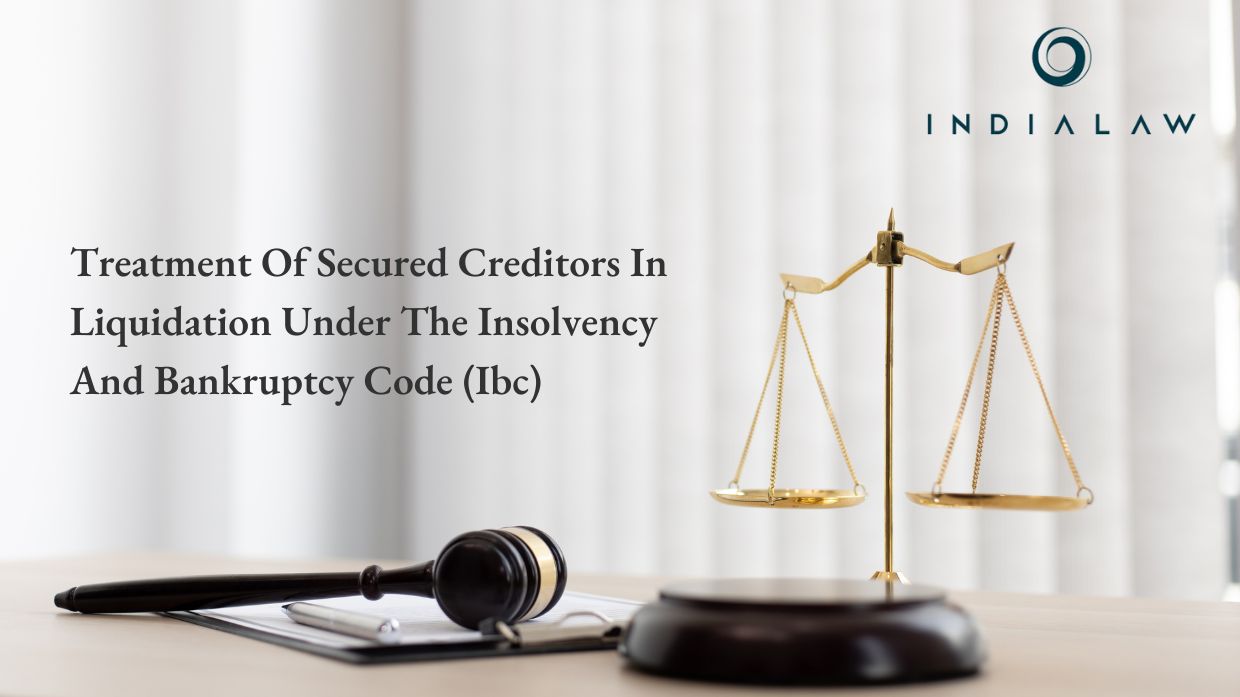Treatment Of Secured Creditors In Liquidation Under The Insolvency And Bankruptcy Code (Ibc)

Insolvency And Bankruptcy Code (IBC)
The Insolvency and Bankruptcy Code (IBC), enacted in May 2016 and effective from December 2016, aims to consolidate and amend laws related to the reorganization and insolvency resolution of corporate persons, partnerships, and individuals in a time-bound manner. The primary objective is to provide an effective legal framework for the timely resolution of insolvency and bankruptcy matters, thereby supporting the proliferation of credit markets, encouraging entrepreneurship, and improving the business environment in India.[1]
Table of Contents
Structure of the IBC
The IBC is divided into two main parts: the Corporate Insolvency Resolution Process (CIRP) and Liquidation. Suppose the Adjudicating Authority (AA) receives an approved resolution plan after the expiry of the CIRP or rejects the plan for non-compliance. In that case, it orders the liquidation of the Corporate Debtor. The Resolution Professional appointed for the CIRP usually acts as the liquidator unless replaced by the AA. Under the IBC, the distribution of proceeds from the sale of the corporate debtor’s assets follows a specific order of priority outlined in Section 53, ensuring fair treatment of creditors and stakeholders.[2]
Priority of Claims Under Section 53
Section 53 of the IBC outlines the priority framework for distributing proceeds from the liquidation estate. Costs associated with the insolvency resolution process and liquidation are prioritized first, followed by workmen’s dues for the preceding twenty-four months and debts owed to secured creditors who have relinquished their security interest.[3] Secured financial creditors, including those with security interests or charges on the Corporate Debtor’s assets, have higher priority than unsecured creditors.
Inter-Creditor and Subordination Agreements
A significant unresolved issue is whether inter-creditor or subordination agreements between creditors will be respected in the payment waterfall of Section 53 of the IBC when a secured creditor relinquishes its security. Typically, first charge holders have higher priority in asset distribution, while second charge holders, having subordinate claims, receive payment only after first charge holders’ claims are satisfied.
The rights of secured creditors over the Corporate Debtor’s assets are governed by the Transfer of the Property Act, 1881 (TP Act) and the Companies Act, 2013. According to Section 100 of the TP Act, when immovable property is used as security for payment without constituting a mortgage, the beneficiary of this security has a charge on the property.[4] Section 48 of the TP Act specifies that if rights over the same immovable property are created at different times, the earlier rights take precedence over the later ones unless a special contract dictates otherwise. This principle is encapsulated by the maxim “Qui prior est tempore potior est jure,” meaning “he who is earlier in time is stronger in law.”
Furthermore, Section 2(16) of the Companies Act, 2013, defines a “charge” as an interest or lien on the property or assets of a company, including a mortgage.[5] This legal framework ensures that the claim of the first charge holder prevails over that of the second charge holder, aligning with Section 48 of the TP Act. In practice, this means that in the event of liquidation, the amount realized from the sale of assets should first be used to satisfy the debt owed to the first charge holder. Only after the first charge holder’s claims are fully satisfied can any remaining balance be distributed to the second charge holder.
Thus, while the IBC’s Section 53 outlines the general priority framework for distributing proceeds during liquidation, secured creditors’ specific rights and priorities, particularly regarding inter-creditor or subordination agreements, are also influenced by the principles established in the TP Act and the Companies Act. This intersection of laws underscores the complexity of resolving inter-creditor disputes and the need for clear legal interpretation to ensure fair treatment of all creditors involved.
Legal Framework and Judicial Precedents
The rights of secured creditors over a corporate debtor’s assets are governed by the Transfer of Property Act, 1881 (TP Act), and the Companies Act, 2013. Section 48 of the TP Act states that the claim of a first charge holder prevails over that of a second charge holder, based on the principle “Qui prior est tempore potior est jure” (he who is earlier in time is stronger in law). The Hon’ble Supreme Court upheld this principle in the case of ICICI Bank Ltd. vs. Sidco Leathers Ltd. (2006).
In ICICI Bank Ltd. vs. Sidco Leathers Ltd. (2006) 10 SCC 452, the Supreme Court addressed the issue of priority rights between first and second charge holders in liquidation proceedings. In this case, ICICI Bank, holding a first charge over Sidco Leathers’ assets, contested Punjab National Bank’s (PNB) second charge.[6] PNB had acknowledged that its charge was subordinate to ICICI’s. The Court ruled that under Section 48 of the TP Act, the first charge holder’s claim prevails over the second charge holder’s claim, applying the principle “Qui prior est tempore potior est jure.”
The Supreme Court held that the Companies Act does not negate this priority and that inter-creditor agreements recognizing such hierarchies must be respected. This decision underscores the legal precedence of earlier charges and the validity of inter-creditor agreements in the liquidation process.
In its judgment, the Supreme Court emphasized that Section 529A of the Companies Act does not explicitly contain provisions regarding the priority among secured creditors. The Court noted that the subject of mortgages and charges, apart from being governed by common law, is also governed by the TP Act and the terms of the contracts between the parties. Specifically, it highlighted that the Parliament did not intend to override the established rights of secured creditors under the TP Act while enacting the Companies Act.
Key excerpts from the Judgment:
Para No. 19: The Court clarified that Section 529A of the Companies Act does not inherently provide for the priority among secured creditors. It reiterated that the rights of secured creditors, especially regarding the priority of charges, are governed by the TP Act and the terms of their contracts. PNB had explicitly acknowledged that its charge was subordinate to ICICI’s first charge, a clear and explicit recognition in its loan agreement and subsequent legal actions.[7]
Para No. 20: The Court asserted that the Parliament cannot be presumed to have taken away a right in property without explicit provision. The right to recover money by enforcing a mortgage is a constitutional right preserved under the TP Act. Therefore, the first charge holder’s claim should prevail over the second charge holder’s claim, consistent with Section 48 of the TP Act, which mandates that earlier rights take precedence.[8]
Para No. 21: The Court further noted that Section 529(1)(c) of the Companies Act speaks to the respective rights of secured creditors vis-à-vis unsecured creditors but does not address the priority among secured creditors. It concluded that in the absence of explicit provisions in the Companies Act regarding the priority of charges, the specific provisions of the TP Act would prevail.[9]
Implications for the IBC:
The Sidco Leathers Ltd. judgment clarified that the priority of claims, as outlined in Section 48 of the TP Act, should be respected even during liquidation under the IBC. Although Section 53 of the IBC provides a general framework for the distribution of proceeds, it does not explicitly address the inter-se priority among secured creditors. Therefore, in the absence of explicit provisions to the contrary, the established legal principles under the TP Act, as affirmed by the Supreme Court, continue to apply. This ensures that the first charge holder’s claim prevails over that of the second charge holder, and inter-creditor agreements recognizing such hierarchies must be respected, preserving the legal rights of secured creditors as intended by the TP Act.
Insolvency Law Committee’s Report
The Insolvency Law Committee’s report, dated March 26, 2018, offers a detailed analysis of the priority of charges among secured creditors within the framework of the Insolvency and Bankruptcy Code (IBC).[10] The report clarifies that Section 53 of the IBC does not explicitly address the priority of claims between secured creditors who have entered into inter-creditor or subordination agreements. Instead, Section 53(1)(b) of IBC primarily aims to rank workmen’s dues equally with debts owed to secured creditors who have relinquished their security.
Priority of Claims Under Section 53
Section 53 of the IBC delineates the order of priority for the distribution of proceeds during the liquidation of a corporate debtor. However, ambiguity exists regarding whether inter-creditor or subordination agreements are respected within this statutory waterfall. Specifically, Section 53(1)(b) stipulates that workmen’s dues and debts owed to secured creditors who have relinquished their security shall rank equally. This raises concerns about whether the phrase “shall rank equally between and among” could imply an equal ranking of debts among secured creditors, potentially undermining the priority established by inter-creditor agreements.
International and Judicial Precedents
The Committee referenced international practices, such as in the USA, where subordination agreements are enforceable in bankruptcy to the same extent as under non-bankruptcy law. This practice supports the principle that valid inter-creditor agreements should govern the relationships between secured creditors during liquidation. The Committee also drew on the ICICI Bank Ltd. vs. Sidco Leathers Ltd. case, where the Supreme Court upheld that the priority rights of secured creditors are preserved unless explicitly abrogated by legislation. The judgment emphasized that the property right is a constitutional right, and the right to recover debts by enforcing a mortgage is an enforceable interest in the property. Section 48 of the Transfer of Property Act (TPA) asserts that the claim of a first charge holder prevails over a second charge holder.[11] Furthermore, the Companies Act does not negate the priority of charges among secured creditors, and legislative silence cannot be construed as depriving secured creditors of their legal rights.
Application of Principles to the IBC
The Committee concluded that the principles established in the Sidco Leathers Ltd. case are applicable under the IBC. Section 53(1)(b) of IBC distinguishes secured creditors who have relinquished their security from unsecured creditors without nullifying the inter-se priority among secured creditors established by inter-creditor agreements.[12] Disregarding such agreements could negatively impact the credit market, dissuading financial institutions from extending large secured loans. Recognizing these agreements fosters creditor confidence and supports a robust credit market.
The Committee determined that Section 53(1)(b) of IBC was intended to rank workmen’s dues equally with debts owed to secured creditors who have relinquished their security without affecting the inter-se priority among secured creditors. Valid inter-creditor and subordination agreements govern the relationships between secured creditors and must be respected within the liquidation waterfall. Therefore, there is no need to amend the IBC, as these agreements should be upheld to ensure a balanced and fair resolution framework, promoting a conducive environment for credit markets and encouraging entrepreneurship and investment in India. This approach aligns with the IBC’s objective of providing an effective legal framework for the timely resolution of insolvency and bankruptcy matters, thereby enhancing the business environment.
Cases before the Hon’ble Supreme Court
The ongoing legal debate regarding the treatment of secured creditors with different charges under the IBC is underscored by the National Company Law Appellate Tribunal (NCLAT) rulings in two significant cases: Oriental Bank of Commerce v. Anil Anchalia and Anr[13] and Technology Development Board v. Anil Goel, Liquidator of Gujarat Oleo Chem Limited and Ors.[14]
In the Oriental Bank of Commerce case, the NCLAT examined the prioritization of claims between secured creditors holding first and second charges on a Corporate Debtor’s assets during insolvency proceedings. The decision, currently under challenge in the Supreme Court (Civil Appeal No. 4664/2022), highlighted ambiguities in Section 53 of the IBC regarding the ranking of secured creditors who have relinquished their security interests. Similarly, in the Technology Development Board case, the NCLAT’s ruling is also under Supreme Court review (Civil Appeal No. 2359/2021), leading to a stay on the NCLAT’s order.
These cases, now consolidated for consideration by the Supreme Court, underscore the complexities surrounding the interpretation and application of the IBC concerning the rights and priorities of secured creditors with different charges. The Supreme Court’s involvement indicates the need for a definitive legal clarification on how inter-creditor and subordination agreements should be treated within the IBC framework, particularly in liquidation proceedings.
Given the pending litigation, it is prudent to await the Supreme Court’s final judgment. This ruling will likely have significant implications for the treatment of secured creditors in insolvency and liquidation cases in India, providing much-needed clarity and legal precedent for future cases.
Conclusion
The Committee’s deliberations and analysis suggest that Section 53 of the IBC needs to explicitly address the priority of claims among secured creditors who have entered into inter-creditor or subordination agreements. Instead, the primary intent of Section 53(1)(b) of the IBC is to rank workmen’s dues equally with debts owed to secured creditors who have relinquished their security. The Committee believes that valid inter-creditor and subordination agreements should govern the relationships between secured creditors and be respected in the liquidation process under Section 53.
The resolution of the issue regarding the treatment of secured creditors with different charges may ultimately be determined by the Hon’ble Supreme Court in the pending cases. However, the Committee’s position is to maintain status quo, emphasizing the importance of respecting valid inter-creditor and subordination agreements in the liquidation process under the IBC. This approach ensures that creditors’ and stakeholders’ rights are treated fairly and that the distribution process is carried out orderly, supporting the overall objectives of the IBC in promoting a robust and efficient insolvency framework in India.
[1]THE INSOLVENCY AND BANKRUPTCY CODE, 2016, No 31, Acts of Parliament,2016 (India).
[2] IBC, supra note 1
[3] IBC, supra note 1
[4] Transfer of Property Act, 1882, s. 100 (India).
[5] Companies Act, 2013, § 2(16) (India).
[6] ICICI Bank Ltd. v. Sidco Leathers Ltd., (2006) 10 SCC 452.
[7] ICICI Bank Ltd. v. Sidco Leathers Ltd., (2006) 10 SCC 452, para. 19.
[8] ICICI Bank Ltd. v. Sidco Leathers Ltd., (2006) 10 SCC 452, para. 20.
[9] ICICI Bank Ltd. v. Sidco Leathers Ltd., (2006) 10 SCC 452, para. 21.
[10] India code: Insolvency and Bankruptcy Code Report, 26th March 2018, Ministry of Law and Justice (2016).
[11] Transfer of Property Act, 1882, § 48 (India).
[12] Insolvency and Bankruptcy Code, 2016, § 53(1)(b) (India).
[13] Oriental Bank of Commerce v. Anil Anchalia and Anr., NCLAT (National Company Law Appellate Tribunal) (2022).
[14] Technology Development Board v. Anil Goel, Liquidator of Gujarat Oleo Chem Limited and Ors., NCLAT (National Company Law Appellate Tribunal) (2020).
By entering the email address you agree to our Privacy Policy.



